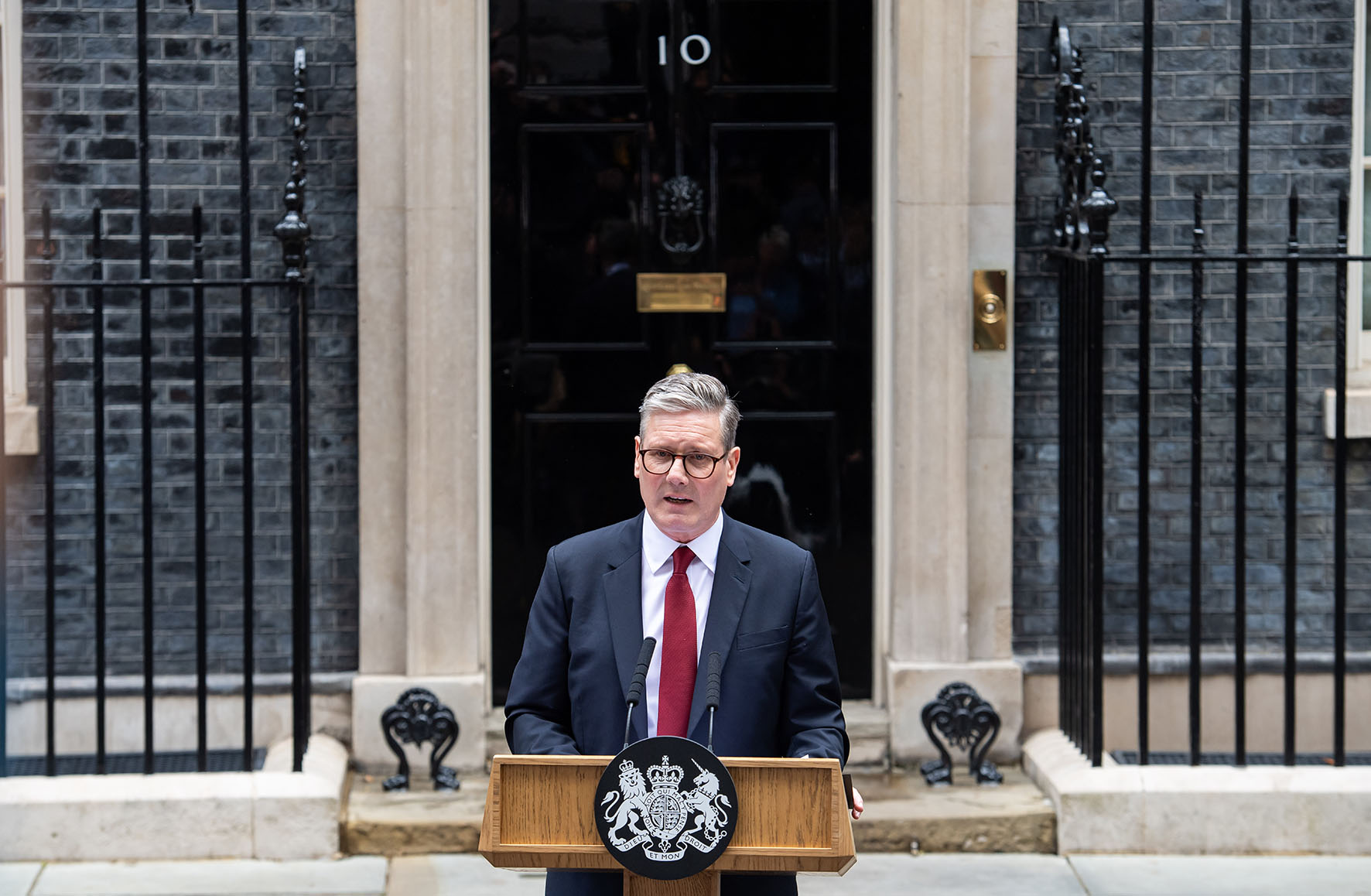“It’s been a long
A long time coming, but I know
A change gon’ come
Oh yes, it will.”
A Change is Gonna Come – Sam Cooke, 1964
Aside from England’s performance in the Euros, politics has continued to dominate headlines. Keir Starmer's so-called loveless landslide delivered an unassailable effective majority of 181 seats, albeit with a lesser share of the vote (36%) than Corbyn’s 40% in 2017 and substantially less than Johnson’s near 44% in 2019. Two thirds of the seats for one third of the votes will no doubt rekindle the proportional representation argument…
Meanwhile, Macron’s decision to mirror Sunak’s by calling a snap election (in this case following a poor showing in the recent European Parliament elections) appears to have gone equally awry with Le Pen’s National Rally Party taking a third of the vote in the first round of France’s legislative election. Tactical voting notwithstanding, the NRP is the dominant force in French politics and reflects similar rightward moves towards populism across Europe. However, following a tactical voting strategy, namely the “republican front”, in the second round of the French election, France’s national assembly finds itself split three ways. The left wing New Popular Front has 180 seats, Macron’s Ensemble with 162 and the RNP with 143.
It’s rare for the US to relegate Orange Man Bad to the inside pages, but the Donald is back (not that he’s ever really been away. Suffice to say that the “lawfare” we have previously described -which inevitably led to increased Trump support and fundraising – has now been raised to an even greater level by Biden’s one-foot-in-the-grave presidential debate performance on 27 June, and the assassination attempt on Former President Trump. Expect endless re-runs (from both sides) of the lowlights between now and November in the attempt, first, by the Democrat Party to replace Biden and, second, by the Republican Party to amplify accusations of conspiracy between the Left and the media.

The UK election received its adrenaline shot through the eighth attempt by Nigel Farage to become an MP. Reform UK’s focus on topics such as immigration and the cost of Net Zero were not readily discussed by either Labour or the Conservatives, but it is clear in the aftermath that the Conservatives suffered enormous damage for failing to address these issues. Astonishingly, YouGov polling analysis indicated that the transfer of only 130,000 “geographical” (for which read tactical) votes from Labour to Conservative would have been sufficient to deny the Labour majority. More amusingly, some wag proclaimed that the Tory candidate should have stood down as the Conservatives were splitting the Reform vote.
What does this mean for our investment strategy? In short, not a lot. We can’t buy (or sell, for that matter) politics. Yes, geopolitics will undoubtedly frame our investment universe over the longer term, but in the shorter term markets dance to their own tune, and that has been the case this time– reflected, for example, in the fact that French stocks were up following the first round election results in June.
Ultimately, we invest into themes that we believe will successfully navigate change and geopolitics to deliver strong gains over the long term; put simply, investing into a company’s future earnings and cash flow. We focus both directly (Global Blue Chip) and indirectly (our multi-manager portfolios) on these valuation metrics to identify reasonably-priced high-quality stocks aligned with our long-term themes. Sensible stuff. We also believe in diversifying portfolios by asset class, sector, stocks and bonds. Similarly sensible stuff. This worked well in Q1 but in Q2 the market returned to behaving strangely – as it did for much of 2023. Once again, the S&P 500 and markets in general were driven by a small number of very large stocks and there was little reward for sensible investing. For instance, the US equity market rose by 4.1% (1) over the quarter. Of that, Technology contributed about 4% (2) and, of that, 3% (3) came from Nvidia and Apple. This type of market can be frustrating and there is a temptation to jump on the band wagon and join the crowd in what is, essentially, an illogical frenzy. However, historically, this has proven time and again to have been the wrong move. This might be mildly excessive and out of context, but I’m reminded of then-CEO of Citigroup, Chuck Prince’s, 2007 statement that “as long as the music is playing, you’ve got to get up and dance.” The bank was bailed out by the US government a year later.
Markets won’t remain like this forever. Even in the last few weeks we have seen relative performance improve as investors start to question inherent biases – thereby rewarding our reasoned approach. Whilst it is impossible to predict exactly when the market will address its imbalances (Mr Market is an emotional and stubborn beast, at times) our job is to remain sensible stewards of our clients’ investments, to think long term, and to manage portfolios accordingly.
Cautious Portfolios
Lower Risk
by Robert (Bob) Tannahill
Objective: The Cautious portfolio’s objective is to increase its value by predominantly allocating capital to fixed income investments. The portfolio can also invest into global blue-chip equities with strong cashflows and progressive dividend policies. A neutral position would be a 75% bond/25% equity split and the maximum equity-weighting of approximately 35%. The cash generated can be re-invested to provide capital or taken as an income stream.
Over the quarter, the cautious strategy returned 1.0% (4) versus the sector which returned 0.6% (5). This brings the portfolios to 2.5% (6) on the year and the sector to 2.1% (7).
While capital-growth-focused investors have been wrestling with how to handle the growing dominance of a small number of big winners in equity markets, life for more cautious investors has been thankfully a bit more straightforward so far this year. Our equities have generally made money as the world seems to be successfully emerging into an “old normal” reminiscent of economies pre-2008. Interest rates are roughly in line with long-term historic norms, economic growth is holding up and inflation is drifting back towards central bank targets, albeit slowly. In the UK we even hit the 2% inflation number in May. Under the bonnet, risks remain: some recent growth data looks a bit weak and, in the inflation numbers, some stickier elements are still running uncomfortably high. The UK services sector number, for example, was worrying at 5.7% in May. These residual concerns combined with a very busy year for elections has left central banks choosing to sit on their hands for now, in terms of interest rates, as they await clearer signs in the data to avoid being accused of political interference. Markets still expect to see a cut or two by year-end as these issues pass; however, start-of-the-year expectations of an aggressive drop in rates is long gone. This adjustment in expectations has been a headwind for bonds albeit, generally, offset by interest income. This is the big difference about investing in bonds today: you are being paid to be patient thanks to attractive levels of income and this provides a buffer against short-term uncertainty. This is why we are of the view that in portfolios you want to maximise income and minimise dependence on macro factors, like interest rates, and then simply wait. So far this year the strategy has worked as predicted, despite moderate headwinds.

Against this backdrop our equity funds have returned between 5% and 10% so far this year with one noteworthy change and two outliers to the downside. On the bond side, our funds were between flat and up 5% year-to-date with one positive outlier and one change.
On the equity side we switched Lazard’s Global Thematic Inflation Opportunities Fund into Ninety One’s Global Quality Dividend Growth fund in Q1. While we still have concerns about the stickiness of inflation, we think that quality growth is probably a better way to position our equities than the more directly exposed stocks in Lazard. This was somewhat vindicated in Q2 as Ninety One put in a strong performance relative to Lazard. The laggards have been our environmental solutions and emerging markets thematic funds, specifically KBI Global Sustainable Infrastructure and Prusik Asian Equity Income. The KBI fund has been weak along with the whole environmental sector this year. We have spoken to the team on a number of occasions, remain happy with the process and portfolio, and see the underlying stocks as quite attractively priced. As such we are not making any changes to this position. Prusik has suffered as they have a material exposure to Hong Kong where the manager sees some extremely attractively-priced stocks. Sentiment is poor towards China (and, by extension, Hong Kong) at present and, while we sympathise with the manager’s approach, we are not convinced that having around 6% of the portfolio waiting for an improvement in that sentiment makes sense for cautious investors. As such we moved to diversify this position by halving the Prusik position and using the proceeds to add an excellent global emerging equity income fund in the form of Pacific EM Equity Income Opportunities.
On the bond side we cut the perennial laggard Allianz Strategic Bond in mid-April. While we bought the fund to perform under certain economic conditions (which didn’t transpire), we felt that the manager had failed to pivot the portfolio to the changing environment and sold accordingly. Since we exited the fund has made no progress, which somewhat vindicates the decision. The top performing bond funds were our valuation plays, where we considered (following the sell-off in 2022) parts of the market were offering excessively good income yields. The top performer was Titan Hybrid Capital Bond, which returned 6.3% (8) on the half-year, driven by strong income generation and some capital appreciation.
Looking forward, we still have attractive income-yields in the portfolio. So, while the ongoing debate around the future paths of growth and inflation will keep buffeting markets, we hope to see total returns for these portfolios, over the next few years, at least in line with their long-term historic averages given the value on offer in bond markets today. worked as predicted, despite moderate headwinds.
Higher Income:
Medium Risk
by Robert (Bob) Tannahill
Objective: The Higher Income portfolio’s objective is to provide investors with a current income that is higher than cash rates. The current income target is 6%. The portfolio invests across a diverse range of assets including dividend paying equities, investment grade and high yield bond and infrastructure investments. The cash generated is taken as an income stream.
Over the quarter the Higher Income strategy returned 0.8% (9), which is behind the run-rate implied by the yield (circa 6%) of 1.5% per quarter. While we received our income as expected, over the quarter capital values in the portfolio fell modestly and we look at the leaders and laggards, below. At the end of the quarter, the fund declared a dividend of around £1.57 per unit (O class) in line with our target income yield.
We review the macro economic developments so far this year in our cautious/income commentary; readers interested in more of the background may want to read that section alongside this update.
Within the portfolio on the equity side, it was a bumpy quarter of divergent returns as markets rotated quite strongly. On average, within our equity allocation, small capital losses were roughly offset by income, leading to a broadly flat total return. Within that the Fidelity Sustainable Global Dividend Plus Fund was the standout winner, rising 3.2% (10), helped by positions in semiconductor names such as TSMC. While the loser was the more value-orientated Schroder Global Dividend Maximiser Fund which fell -3.9% (11). We saw the Schroder team in April and did not have any concerns about the fund at that stage. It has, however, had a tough second quarter since we saw them; we will keep a close eye on the fund in the coming months.
The core bond positions in the portfolio were generally stable and accrued income, as expected. This led to total returns generally between 1.3% (12) and 2.7% (13) on the quarter. The one outlier was our higher-grade bond fund, Rathbone Ethical Bond, which struggled a bit, returning 0.2% (14) over the period, as bond markets continue to track the latest economic data releases in minute detail.
The two more volatile investment trust positions continued to move around over the quarter. Ultimately the Sequioa Economic Infrastructure Income Fund (SEQI) ended the quarter in a slightly positive position, at 0.8% (15), while The Renewables Infrastructure Group (TRIG) ended down -3.6% (16). These positions switched several times over the quarter as all investment trusts remained volatile. SEQI published results over the period: while they have had an issue with one loan to a UK-based healthcare provider – about which we are due to have a specific call – we remain happy that the fund is well managed and navigating a difficult period for trusts as well as is possible. TRIG, due to the higher risk nature of its assets, has had a tougher time. They are due to report to investors on the 9th of August and we will review the position following that update.
Looking forward, we have an estimated forward-looking income yield on the portfolio in excess of 6%, which gives a solid base from which to keep delivering income and provides a buffer against short-term noise, whatever the near-term path of growth and inflation.
Balanced Portfolios:
Medium Risk
by David Le Cornu
Objective: The Balanced portfolio’s objective is to provide capital appreciation through a balance of fixed income and global equities. A neutral position is a 50% bond/50% equity split and the maximum equity weighting is 60%. The cash generated can be re-invested to provide capital or taken as an income stream.
Elections have dominated the news over the quarter and year to-date. This is unsurprising since roughly half the world is scheduled to have an election in 2024. Clearly, President Macron was feeling left out and overconfident in calling an unnecessary general election in France, which has only served to highlight his government’s unpopularity. So far, globally, results suggest an unhappy electorate voting for change and leaning more to the political right than when they last cast their votes. Whether this change of direction is good for their financial health only time will tell.
In this environment, over the quarter and year to-date, the Balanced strategy has advanced 0.8% (17)/ 3.6% (18), which compares to a return of 0.8% (19)/ 3.7% (20) respectively from the IA 20-60 index.
The good news is that as the year progresses and elections are decided the political distraction will begin to fade and we can all focus upon the things that matter for long-term investors, including inflation, interest rates, economic activity and corporate earnings. We continue to expect global interest rates to fall during the second half of the year, which will be supportive for economic activity, ease some of the mortgage burden for homeowners and should allow equity and bond markets to progress from present levels.
The focus of investment activity during the quarter has been to reposition our Asian and Emerging Market holdings for the changing world. We have commented before regarding the change in the relationship between America and China, the fracturing of globalisation, the establishment of narrower trading blocs and friend-shoring. This has prompted a decision to improve the geographic spread in order to reduce reliance upon Chinese and Hong Kong equities in driving the performance in this part of the Balanced portfolio. At the same time, we wanted to ensure we didn’t have a pronounced style bias, remained aligned with our core themes and increased exposure to small capitalisation equities – which appear attractively valued by historic standards.

Our emerging market equity exposure has increased from +7% to +9% as we sold First State Asian Growth (-3%) and Prusik Asian Equity Income fund (-4%) but introduced: (i) Polar Asian Stars (+3%); (ii) Pacific North of South EM Equity Income fund (+3%); and, (iii) Aberdeen EM smaller Companies fund (+3%). The first provides an attractive equally weighted blend of a highly thematic growth fund with an innovation tilt with key exposures, including domestic growth in India and the new CAPEX cycle, technology/semiconductor recovery, friend-shoring, electric vehicles, commodities and Vietnam. The second is a value-and-income-focused fund aiming to deliver a dividend yield in excess of inflation and attractive capital growth presently yielding 7% and includes exposure to Middle East, South America, Eastern Europe and Africa. The third is a small capitalisation global emerging markets equity fund.
In June, we sold Robeco Smart Materials (-3%) from our environmental solutions holdings and replaced it with Pictet Global Environmental Solutions (+3%). We continue to hold Robeco Smart Materials in a number of other strategies but considered that the broader diversification and lower volatility provided by Pictet GEO was better suited to our Balanced investment objective.
With so much global change, we have been working hard to ensure that the portfolio is appropriate for the future. A detailed review of our level of exposure to global equity markets and the blend of funds we use has been ongoing for many months. You will see some changes ripple across the Ravenscroft range of investment strategies over coming months.
Growth Portfolios:
Higher Risk
by Samantha Dovey
Objective: The Growth portfolio’s objective is to provide long-term capital appreciation by investing predominantly into global equities. A neutral position is a 25% bond/75% equity split and the maximum equity weighting is approximately 85%.
Over the quarter and year to-date, the Growth strategy has advanced 0.3% / 5.2% (21), which compares to a return of 1.7%/ 5.9% (22) respectively from the IA 40-85 index.
At the underlying fund level, we are starting to sound like a broken record: our global equity funds have not kept up with the generic world index due to our underweight exposure to the Magnificent Seven – who posted 3% over the quarter (23).
When we look at the technology/AI exposure within the fund, both funds have outperformed the world index, which you would expect.

Our emerging market exposure over the quarter was marginally behind the index, as a weighted allocation, since tech was also helpful in this region and the only fund where we have a significant exposure is Polar Asian Stars (Tom Yarwood covers this in our Fund in Focus article).
Our other themes such as environmental solutions and healthcare did not keep up with the index this quarter. Whilst the traditional energy exposure was marginally positive over the quarter, the energy transition fund had a tough time.
Fixed income is a small part of the portfolio, and overall is short-dated in nature; I am pleased to report that all funds were ahead of the bond index for the quarter.
Trades
Last quarter we touched upon the emerging market review and the trades executed. This quarter we sold Robeco Smart Materials and bought back Pictet Global Environmental Opportunities; this trade was also mirrored in our balanced strategy, so please read the balanced quarterly for the rationale.
Review
As investors in our multi-manager offerings may know, we constantly review our long-term investment themes to ensure that they are as relevant today as they were historically – and, equally importantly, will remain so for the decade to come. On the whole, the themes are long-term in nature, although the way we access them can be “tweaked.” For example, buying the AI fund last year was a direct play on the future of innovation.
As well as looking at the themes, we also have to review the underlying holdings to ensure that they are doing the job for which they were employed. Q2 was all about global equity. Here we met all our existing managers face-to-face in London, as well as two new funds that we have been watching for a while but wanted to meet. In Growth we have three global equity exposures: two meetings went well and one not so well. The two new fund managers, however, were exceptional.
As you would expect, the meetings led us to revise our global equity exposure within the strategy: we will be saying goodbye to one manager and hello to the two new managers. The overall allocation will remain the same, but we will be spreading the love to ensure what we consider the best allocation for the future.
Global Blue Chip Portfolios:
Higher Risk
by Ben Byrom
Objective: The Global Blue Chip portfolio invests into approximately 25-30 global blue chips that are in line with our long-term investment themes. The aim is to invest into such companies at an attractive valuation and hold them for the long term. The cash generated can be reinvested to provide capital growth or taken as an income stream.
The rally in stocks slowed in Q2 with the MSCI World Total Return (Net) registering a 2.6% (24) return in GBP. In contrast, the Global Blue Chip strategy returned -5.84% (25).
Performance Breakdown
Looking at the performance through the lens of our themes and the most appropriate sectors helps us break down what happened from a relative perspective.
Ageing Demographics – Healthcare Sector (including the life sciences)
Despite a strong recovery in June, our healthcare holdings could not recover the losses incurred during the early part of the quarter. The sector was home to both the worst contributing holding and the best.
The share-price performance of life science company Bruker was very disappointing in Q2, albeit not due to any developments in the business, so far as we are concerned. Up until late March the shares had been performing extremely well, in part due to the company's exceptional underlying performance against a difficult background in the life science tools industry. But Bruker’s shares are not immune to movements in sympathy with its peers, and this is what started to take hold in early Q2. In late April, Bruker announced that it would acquire the assets of NanoString out of bankruptcy, while several weeks later they announced a modest-sized share issue to help fund the acquisition – these announcements prompted the next leg-down in Bruker’s shares. Management hosted a “mini Investor Day” during the quarter to explain their strategy. We believe management to be credible and remain very excited about the direction of the business in the years ahead, including a very significant ramp in earnings starting from next year. The shares are now at about their cheapest valuation in 10 years.
In late June, Alnylam announced the headline results of an important clinical trial – one of the most hotly anticipated events in biopharma this year. The company provided conclusive evidence that its medicine Vutrisiran significantly reduces the risk of death and improves quality of life in patients with ATTR amyloidosis with cardiomyopathy (a progressive heart disease with a large patient population). Anticipating approval by the relevant regulatory authorities, investors began to appreciate the magnitude of the opportunity in front of Alnylam, sending the shares up almost 60% in the last week of Q2.
Global Consumerism – Consumer Staples and Discretionary Sectors
Consumer stocks were the biggest drag on performance for a number of individual reasons, but Estée Lauder and Nike ended the quarter as two of our biggest detractors to performance.
Estée Lauder disappointed the market with their latest earnings update after they revised down their revenue sales growth guidance due to the slower than anticipated recovery in mainland China. A short-term issue that will have a limited impact on the long-term opportunities for the company in our view. Our thesis is largely playing out with the inventory situation improving and demand from the underlying consumer outstripping the reported sales into the Asia Travel Retail business. As with a number of businesses purchased over the past six months, the company is at an inflection point having disappointed investors for a number of years now. It will take time to rebuild confidence but when it comes (and we believe it will) the shares will rerate accordingly.
Technology & Innovation – Technology and Communication Services
Technology was a bright spot during a somewhat bleak quarter, carried somewhat by some of the biggest technology stocks in the index. Nonetheless, we had our share of success too with Oracle, Adobe, and Netflix entering the top five contributors whilst Disney remains under scrutiny.
Yet it was Oracle which was our best contributing share in this theme during the quarter following its full-year results. The size and growth of Oracle’s order book appeared to catch investors unawares and was received very positively. Growth is being driven, in particular, by Oracle’s differentiated cloud infrastructure, with an outsized share coming from AI customers, such as OpenAI.
10 years Old!
Despite the torrid quarter, Blue Chip did make an historic milestone passing its 10-year anniversary at the quarter’s end. We marked this event with a short note (which can be read here) accompanied by a quiz based on some of the businesses we have invested in. Entrants have the chance to win a series of prizes and we would encourage you to enter – please see our website for details. We would like to take this opportunity to thank all our investors for your support over the years and our desire to serve you burns just as brightly today as it did when we launched.
Through each quarter we write a number of articles on stocks that we own (or do not), often tying in aspects of our process to offer more context to interested clients. During the quarter we have discussed the following:
- The impact of noise and how we can reduce it to make better judgement calls – Silence is Golden
- Netflix’s Quarterly Earnings, an illustration of the Precision Fallacy – Ta’dum(b)
- Why are stocks experiencing heightened volatility when broader index volatility is declining? – What’s with the Volatility
- The risk/reward around owning NVIDIA – I want to talk about NVIDIA
Global Solutions:
Higher Risk
by Shannon Lancaster
Objective: To generate capital growth over the long term (over 5-10 years). The strategy invests into 10-20 carefully selected third party equity funds; following the same, stringent investment process as the other multi-manager portfolios in our range. It is a highly focused portfolio which invests in companies providing goods and services dedicated to finding solutions to the challenges the world faces today.
Over the quarter the Global Solutions strategy returned -1.8% (26).
Continued enthusiasm for artificial intelligence over the second quarter helped the technology sector maintain its lead as top performer this year. Companies involved in chips, cloud computing, and data centres saw strong demand with the market star NVIDIA becoming briefly the most valuable company in the world. Pleasingly, over the past few months, the market has started to recognise that infrastructure is the second order, and often overlooked, beneficiary of artificial intelligence. The soaring demand for electricity from data centres and other energy intensive industries has resulted in defensive utilities being one of the best performing sectors since mid-April, staging a remarkable turnaround.
Brookfield Sustainable and Renewable Infrastructure and KBI Sustainable Infrastructure have significant exposure to this sector which contributed positively to performance over the quarter.
As we have mentioned in previous pieces, artificial intelligence is a multi-sector opportunity which we can access in numerous ways. We own various global beneficiaries throughout the portfolio. Renewable developers should benefit from the buildout of incremental power capacity and higher power prices. Moving one step down the value chain, the suppliers of renewable power generation and ancillary equipment skewed to the US utility-scale projects, such as Vestas, First Solar and Array, all stand to benefit. To maximise the utility of the generation of clean power, we will need more efficient battery solutions which businesses like Fluence are focused on. These are powered by cells from companies like Samsung SDI and CATL which should all see an increase in demand.

Energy transition exposure has been volatile this year and performance can be quite different depending on where you are invested along the value chain. While Brookfield and KBI did well, Schroder Energy Transition was bottom of the pack over the quarter. So, why has the space been so volatile? A number of cyclical pressures came to a head this year. ETF outflows, demand weakness and pricing pressure have impacted many of the key energy transition sectors. Our fund managers are mindful that this volatility could continue but they are seeing some positive signs. The mid- to long-term growth outlook for these businesses is strong and the risk-reward for the investment theme looks attractive. They have been taking advantage of market movements to add to certain areas that have de-rated but still have great long-term prospects and strong fundamentals.
Emerging markets enjoyed a positive quarter. Defensive areas like healthcare and consumer staples were negative over Q2 and more growth-orientated technology and communication services performed strongly. Impax Asian Environment was a top contributor to performance benefitting from a number of high conviction names, including TSMC, which has enjoyed very strong performance this year. Other lesser-known names have also been positive. SK Hynix returned over 20% in June making it the second largest business in the Korean index, trailing only behind Samsung.
Chinese renewables enjoyed good performance in May but in June were challenged by policy changes and tariffs proposed by the Biden administration. The companies that we have exposure to in the affected supply chains have relatively low revenue exposure to the US market and its unlikely that any changes would have a material impact on their fundamentals or growth potential.
Interestingly, policy support for these industries continues to evolve from the Chinese government, with supply side-reform within the Chinese battery and solar supply chains. This should provide more stability for these businesses and encourage healthier market development.
As we take a step into H2, we anticipate the noise to continue with global elections and interest-rate decisions taking centre stage. We will continue to focus on where we can add value, stick to our knitting, and remain invested for the long term.
Fund in Focus:
Polar Asian Stars
by Tom Yarwood
Following a series of thematic reviews, the Ravenscroft multi-manager team reassessed the emerging market (EM) exposure and made a number of changes, including the addition of Polar Asian Stars.
The fund is focused on growth opportunities across Asia, which, alongside other EM holdings, provides exposure to a diversified blend of companies that can navigate the different investment opportunities that EM provide.
The Polar process results in an actively managed, high conviction portfolio of typically 45-55 stocks with a high active share. The manager, Jorry Nøddekær, is head of the Polar Capital EM and Asia team and boasts 24 years of industry experience, navigating various market environments and providing consistent performance. The portfolio enjoys strong earnings growth, currently in the mid-30s, whilst its high allocation to information technology provides an innovation tilt for our emerging market allocation.
Polar Asian Stars is a long-only, highly thematic Asian equity fund that aligns well with Ravenscroft’s thematic investing approach and particularly the theme of the Rise of the Emerging Consumer, investing in the sectors we prefer like consumption and innovation – Asia dominates chip production and the electronics industry to some extent.

The Polar team sets itself apart with its unique investment strategy in Asia. They focus on identifying ‘Star’ companies, which are typically found in sectors experiencing significant supply and demand imbalances. These imbalances are the result of interactions between industrial and country dynamics and, the stronger these interactions, the higher the potential for value creation. By meeting with company management, consulting industry experts, reviewing research and engaging with analysts, the Polar team can accurately identify these high-growth areas. Their strong emphasis on understanding the supply side of the market gives them an edge over their competitors, helping the team to pinpoint key growth opportunities. This is crucial, as portfolio performance is driven by stock picking in the most promising areas.
The team refines its investment universe by identifying a number of key growth areas across Asia. A more connected world with more data and machines means the portfolio has significant exposure to technology, diversified across multiple sub-sectors such as semiconductors, green metals, electric vehicle battery technology, renewable energy and new manufacturing supply-chains. These areas are benefiting from the current redesign and restructuring of globalisation and tilts the fund’s exposure towards North Asia.
Another promising growth area is domestic-driven consumption stemming from increasing wealth, urbanisation and stronger demographics. Whilst China is still an important story here, countries like India, Vietnam and Indonesia offer exciting opportunities for stock pickers. Leveraging these megatrends aligns well with the Ravenscroft team’s thematic approach to investing whilst also harnessing long-term growth across Asia.
The Fund has a broad market-cap mix with c.60% in large-cap stocks; as such it has exposure to big Asian names like TSMC, Samsung and Tencent. These large businesses can help dampen volatility and protect on the downside when markets are challenging whilst also aiming to capture the upside when markets are doing well. The remainder of the portfolio is invested further down the market-cap spectrum, helping to differentiate the strategy to its peer group as well as provide investors with exciting, lesser known or covered opportunities.
Since launch in April 2011, the fund has posted 60% (26) vs 26.15% (27) for their benchmark, the MSCI Asia ex-Japan Index. The team’s extensive Asian market knowledge is reflected by this long-proven track record against the benchmark. In terms of more recent performance, YTD the fund has returned 7.08% (28) in GBP vs 5.32% (29) for the benchmark.
It’s pleasing to see the strategy performing as expected, given current market conditions, and the team believes it should be a useful thematic lever in portfolios going forward.
Boscher's Big Picture:
Things are Improving Despite the Noise - A Good Time to Invest
by Kevin Boscher
At the half-year point, it is looking increasingly likely that the US will enjoy a “soft landing” and that major economies will avoid recession at the same time as disinflation will allow central banks to start a rate cutting cycle very soon. This is unambiguously bullish for risk assets, and equities in particular, despite the uncertain and volatile geo-political backdrop.
In the US, economic activity is robust thanks largely to a strong consumer and a free-spending government. It is true that there are some early signs that consumers are beginning to feel more stretched as higher prices and falling savings begins to bite and employment markets begin to weaken. Also, whilst the fiscal deficit will remain elevated whoever wins the election, the impact on growth will be less positive moving forward. In the absence of a major policy mistake by the Fed or the emergence of a new global economic shock, the US will enjoy a soft landing and growth should begin to re-accelerate into next year as monetary policy is eased and the global economy improves.
Importantly, the inflation outlook in the US and elsewhere continues to improve, either meeting or beating market expectations. US unit labour costs have collapsed – partly thanks to rising productivity – and the labour market is softening. This suggests that there is now little reason for the Fed not to start cutting rates soon. This is especially true as the Fed has a dual mandate to support employment as well. The growth and inflation story in the UK and Europe is similar but for partially different reasons.
Many bond markets currently offer the positive combination of attractive yields together with the prospect of some capital appreciation as interest rates fall. However, care is required and investors in longer-dated maturities are demanding a higher yield (risk premium) for a number of reasons. First, Western governments are running bigger fiscal deficits as they tackle their numerous spending challenges, led by the US. This will likely result in higher bond issuance and the potential for currency devaluations. Second, it remains unclear whether the global economy is transitioning back towards the powerful secular disinflationary forces that prevailed prior to the pandemic (Ice) or whether we are moving towards a period of higher inflation similar to the 1970s and early 80s (Fire). Third, credit market spreads (excess yield over the equivalent government issue) are at near-record low levels leaving plenty of room for disappointment should the growth outlook come in worse than expected. Given these risks, we continue to favour shorter-dated maturities, quality corporate credits and specialist opportunities for our bond exposure.

Further, equities are likely in a long-term bull market for a number of reasons. First, rising corporate profits are the key long-term driver of equity returns and the current profit cycle is young. Second, and as already mentioned, we are in a period of disinflation, which is likely to continue and enable the Fed and other central banks to embark on a rate-cutting cycle in the very near future. This will help investors focus on an improving growth and liquidity outlook later this year. Third, whilst valuations look expensive in some areas, namely some of the Magnificent Seven, they look much more reasonable in many markets and sectors. A potential fourth reason for optimism is that we appear to be in the early stages of a new cycle of increased capital investment by business, which could have the impact of increasing potential growth through rising productivity but in a non-inflationary way – similarly to the US in the mid-1990s, where the US economy was able to grow in excess of 4% in real terms at the same time as inflation and interest rates were falling. Equities have enjoyed a good recovery since last October and are pricing in quite a lot of good news. Hence, we could get a setback over the next few months due to several threats; however, given the broadly supportive macro backdrop, any pullbacks should be used as an opportunity to add to equity weightings.
It is well understood that the breadth of the US stock market rally over the past year or so is very narrow and that this presents a threat going forward. The Magnificent Seven now represents some 34% of the S&P500, up from 21% in early 2023. Whilst much of this strength and outperformance can be justified – given the relatively favourable financial fundamentals that many of these stocks exhibit – it is also true that the vast majority of US, and indeed global, stocks have either fallen or stagnated for some time. This is largely reflective of the impact that higher rates and a tight monetary policy has had on slowing the economy. Falling interest rates, easing liquidity pressures and an improving growth outlook should lead to a broader market recovery and include sectors which have so far struggled, including cyclicals, value and even some underperforming quality growth stocks, such as Healthcare. The macro backdrop remains favourable for all of our core themes, including emerging markets.
In summary, inflation is moving closer to the central banks’ target, economies are expanding (but at a slower pace) and the case for the Fed and other central banks to cut interest rates is strengthening. The main risks for this rosy scenario are an escalation in geopolitical tensions and/or a policy error by the Fed, whereby they keep monetary policy too tight for too long precipitating social unrest around the US election. In addition, we will have to get used to investing in a challenging and uncertain environment – since it is highly likely that the post pandemic world will continue to change and evolve in many ways, some of which we can’t foresee. Nevertheless, the next few years should be a positive environment for both bonds and equities – and now would appear to be a good time to increase exposure to risk assets. Cash will remain a very important asset class and we are not about to return to a zero-rate world, although cash returns will fall as rates decline. At the same time, investors should be handsomely rewarded for taking on more risk in bonds and equities. economy improves.


